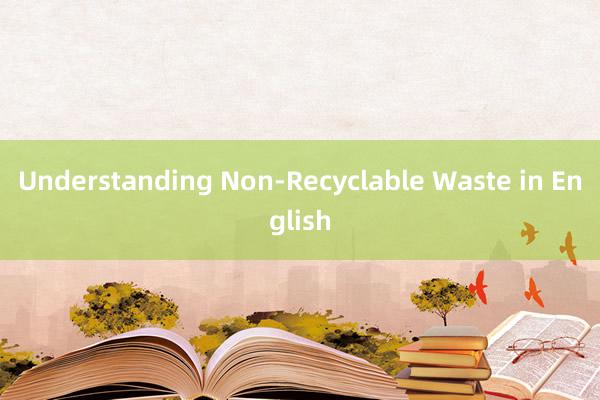
时间:2024-09-10 05:40

### Understanding Non-Recyclable Waste in English
In today's world, waste management is a critical aspect of environmental sustainability. The concept of recycling has gained significant traction as a means to reduce the volume of waste and conserve natural resources. However, not all materials can be recycled, leading to the existence of non-recyclable waste. Understanding this type of waste is crucial for effective waste management strategies and for raising awareness about the importance of reducing overall consumption and promoting more sustainable practices.
#### Definition of Non-Recyclable Waste
Non-recyclable waste refers to materials that cannot be processed through traditional recycling methods due to their composition, properties, or lack of suitable recycling technologies. Common examples include certain types of plastics (like #4 and #6), polystyrene foam, electronic waste with batteries, and some forms of contaminated paper and plastic packaging.
#### Challenges of Non-Recyclable Waste
The primary challenge with non-recyclable waste lies in its disposal. Unlike recyclable materials,紫陌寒 which can be transformed into new products, 恒富物业 non-recyclables often end up in landfills, where they take centuries to decompose, releasing harmful gases like methane and contributing to climate change. Additionally,上海勇如科技中心 these materials can contaminate soil and water sources, posing risks to both human health and ecosystems.
#### Environmental Implications
The accumulation of non-recyclable waste exacerbates environmental degradation. It leads to the depletion of natural resources, as the extraction of raw materials to replace these wastes continues to occur. Moreover, it contributes to the destruction of habitats, as land is converted into landfills to accommodate the increasing volume of waste.
#### Solutions and Innovations
Addressing the issue of non-recyclable waste requires a multifaceted approach. Innovations in material science and technology are essential to develop new types of materials that are more easily recyclable or biodegradable. Recycling infrastructure needs to be improved, including better sorting systems that can handle more complex materials. Additionally, public education plays a crucial role in encouraging consumers to choose products with less non-recyclable components and to adopt more sustainable consumption habits.
#### Conclusion
企业-利安浩咖啡有限公司Understanding non-recyclable waste is fundamental to developing effective waste management policies and practices. It highlights the need for innovation, technological advancement, and societal changes towards more sustainable lifestyles. By recognizing the limitations of current recycling capabilities and focusing on reducing waste production, we can work towards a more environmentally conscious future.
This understanding not only aids in managing waste more efficiently but also fosters a broader conversation around the importance of conservation, resource efficiency上海勇如科技中心, and the circular economy principles.
